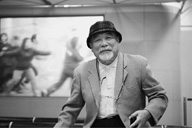Juror
Kawakami Koichi
 [Juror’s Statement]
[Juror’s Statement]
Forty-three years ago I spent approximately two years living in Heta village, Narita, as chief assistant cinematographer on the Ogawa Productions films Narita: The Building of the Iwayama Tower (1972) and Narita: Heta Village (1973). During those two years we not only made films but also helped out the farmers in planting and harvesting rice, and digging up daikon radishes. Looking back, it went beyond the relationship of filmmaker/subject, and was more about creating deeper human relationships with the people of Heta village. It was also a time when we listened to the stories of director Ogawa Shinsuke daily.
Night after night, Ogawa spoke not of cinematic techniques but of the people who live in the village, its history, its festivities and its crops. It was quintessential Ogawa: his “school.” I believe it is during those conversations that the decision was made to adopt a technique whereby the cameraman would just keep rolling from the moment the camera was turned on, until all the film ran out.
Ogawa Productions later relocated to Yamagata, but because I moved into the world of feature films, I didn’t take part in the life there. And when I was asked to serve as a juror for this year’s YIDFF New Asian Currents program I wasn’t sure whether I was the right person for the job. Nevertheless, as this will be a unique opportunity for me to view eighteen films from across Asia, I am very much looking forward to it.
As I watch each film I imagine I will recall the days I spent with Ogawa Shinsuke and the Ogawa Productions staff.
Director of photography. Professor, Japan Institute of the Moving Image. Vice Chairman, Japanese Society of Cinematographers. Joined Ogawa Productions during the Narita era. After working on such films as Filmmaking and the Way to the Village (1973, Dir. Fukuda Katsuhiko) Kawakami made his feature film debut as a cinematographer with Third/A Boy Called Third Base (1978, Dir. Higashi Yoichi). He received the “New Face” Award in the Minister of Education’s Awards for Fine Arts and the Miura Award (Japan Society of Cinematographers award for new cinematographers), among others, for Natsuko of All Seasons (1980, Dir. Higashi Yoichi). He has twice been the recipient of the Mainichi Film Award for Best Cinematography for River with No Bridge (1992, Dir. Higashi Yoichi) and The Blossoming of Etsuko Kamiya (2006, Dir. Kuroki Kazuo). His most recent film is This Country’s Sky (2015, Dir. Arai Haruhiko).
The Blossoming of Etsuko Kamiya
(Kamiya Estuko no seishun)- JAPAN / 2006 / Japanese / Color / 35mm / 111 min
Director: Kuroki Kazuo
Script: Kuroki Kazuo, Yamada Hideki
Based on a Play by: Matsuda Masataka
Photography: Kawakami Koichi
Editing: Okuhara Yoshiyuki
Sound: Kubota Yukio Art Design: Kimura Takeo
Music: Matsumura Teizo
Cast: Harada Tomoyo, Nagase Masatoshi, Matsuoka Shunsuke, Honjo Manami, Kobayashi Kaoru
Production Companies: Bandai Visual, Ad-Gear, TV Asahi, Waco, Pal Entertainments Production
World Sales: Pal Entertainments Production
Kagoshima, 1945. As the war draws to a close, Akashi and Nagayo, two young men of the Navy Air Service, pay a visit to Kamiya Etsuko. Upon Akashi’s insistence, Etsuko reluctantly agrees to a date with his friend Nagayo. Although Etsuko secretly harbors feelings for Akashi, she is impressed by Nagayo’s sincerity. Shortly thereafter, Akashi is sent on a kamikaze mission. Knowing he will not return, he entrusts Nagayo with a letter to Etsuko. With heavy hearts, the remaining couple decide to spend their lives together. Director Kuroki Kazuo’s cinematic adaption of a play by Matsuda Masataka is modeled on the story of the playwright’s own mother. It became the late director’s final film.
